Below are a number of "sketches," as they were called in the 1900's, taken from the Wigan Examiner. They are what we would call pen-pictures today and explore a little of the player's background information and career. During the period covered, 1906 to 1908, photography in local newspapers was still quite a rarity and therefore we are privileged to be able to see an image the players.
Tom Jones

The Wigan Town Club is exceptionally fortunate in being able to command the services of such a fine player as Tom Jones, who last season had the honour of captaining the Hull City team. Jones, as will be seen from the splendid photograph we produce above, has the appearance of a fine
athlete, and what is more his records show he is fitted to take a place in the best of company in more than one pastime.
Seeing that the promoters of the Wigan Town organisation are making a bold attempt to place the “soccer” code on a sound footing in our midst, we shall from time to time deal with the careers of some of the men who are assisting in that object, and we now briefly sketch the “past” of Jones, who has been deputed to lead the Springfield Park contingent.
Jones was born in Shrewsbury on the 14th of August 1883, and first began playing football on attaining the age of eighteen years, when he joined Shrewsbury Town and figured at left back. He shaped so well that at the end of the season he was signed on by West Bromwich Albion, and during the next two seasons appeared with them in most of their Second Division engagements. Whilst connected with the Bromwich club he gained possession of several medals.
West Bromwich getting into a somewhat precarious condition, Jones was allowed his transfer, and he was snatched up by Hull City for the season 1904-5. He was still with the Hull organisation when it joined the League for the season 1905-6, and as captain he carried the Third Porters through a very successful period.
As a professional cricketer the man now at the Wigan Town helm this season discovered his cricket engagements interfering with the calls of the Hull City Club, and that is the reason why he is not still identified with the Tyke team. For the last four seasons Jones has been identified with the Golcar cricket eleven, which is considered one of the finest local cricket teams in the county of many acres, and he has a splendid average both with the bat and ball. We trust that Jones will experience the best of luck, and that he will lead Wigan Town to many a victory.
(Wigan Examiner : September 6 1906 : page , column 5/6)
Jones also had a short spell with Wigan County prior to his Shrewsbury Town days. By 1911 he was living in Golcar (Huddersfield) and working as a blacksmith for the local gas board.
athlete, and what is more his records show he is fitted to take a place in the best of company in more than one pastime.
Seeing that the promoters of the Wigan Town organisation are making a bold attempt to place the “soccer” code on a sound footing in our midst, we shall from time to time deal with the careers of some of the men who are assisting in that object, and we now briefly sketch the “past” of Jones, who has been deputed to lead the Springfield Park contingent.
Jones was born in Shrewsbury on the 14th of August 1883, and first began playing football on attaining the age of eighteen years, when he joined Shrewsbury Town and figured at left back. He shaped so well that at the end of the season he was signed on by West Bromwich Albion, and during the next two seasons appeared with them in most of their Second Division engagements. Whilst connected with the Bromwich club he gained possession of several medals.
West Bromwich getting into a somewhat precarious condition, Jones was allowed his transfer, and he was snatched up by Hull City for the season 1904-5. He was still with the Hull organisation when it joined the League for the season 1905-6, and as captain he carried the Third Porters through a very successful period.
As a professional cricketer the man now at the Wigan Town helm this season discovered his cricket engagements interfering with the calls of the Hull City Club, and that is the reason why he is not still identified with the Tyke team. For the last four seasons Jones has been identified with the Golcar cricket eleven, which is considered one of the finest local cricket teams in the county of many acres, and he has a splendid average both with the bat and ball. We trust that Jones will experience the best of luck, and that he will lead Wigan Town to many a victory.
(Wigan Examiner : September 6 1906 : page , column 5/6)
Jones also had a short spell with Wigan County prior to his Shrewsbury Town days. By 1911 he was living in Golcar (Huddersfield) and working as a blacksmith for the local gas board.
Ernie Tudor

We have pleasure in presenting to our readers this week Ernest Tudor, of Wigan Town, one of the most conspicuous exponents figuring in the ranks of that organisation. This was fully demonstrated on Saturday, when turning out for the first time after a rather serious illness, Tudor accomplished the rare feat of scoring three goals in one half, the “hat trick” being accomplished in the second portion of the game against the Druids.
Being very small in stature - he is only five feet four inches in height – Tudor, who plays inside left, has to “stand the racket” when opposing a full-back adopting vigorous tactics: but he invariably comes up smiling again.
The subject of our sketch was a member of the Kirkham Club in 1901-2, and in the following year he became attached to Frenchwood Villa, a junior organisation who won the Preston Junior Championship, and repeated the performance the following season.
He next joined Clayton Green and subsequently Fulwood United. During his association with the latter club they won the Preston and District League, and also the cup given by the league. He was the recipient, along with other players of two gold medals, and he received another gold medal the following season when assisting Preston Corinthians, who were runners-up in the Preston Thursday League.
Tudor has been chosen on several occasions to play for the League against Preston North End Reserves, with whom he has also figure. He is 22 years of age and weighs 10 stone 4lbs.
(Wigan Examiner : December 12 1906 : page 3, column 1)
Being very small in stature - he is only five feet four inches in height – Tudor, who plays inside left, has to “stand the racket” when opposing a full-back adopting vigorous tactics: but he invariably comes up smiling again.
The subject of our sketch was a member of the Kirkham Club in 1901-2, and in the following year he became attached to Frenchwood Villa, a junior organisation who won the Preston Junior Championship, and repeated the performance the following season.
He next joined Clayton Green and subsequently Fulwood United. During his association with the latter club they won the Preston and District League, and also the cup given by the league. He was the recipient, along with other players of two gold medals, and he received another gold medal the following season when assisting Preston Corinthians, who were runners-up in the Preston Thursday League.
Tudor has been chosen on several occasions to play for the League against Preston North End Reserves, with whom he has also figure. He is 22 years of age and weighs 10 stone 4lbs.
(Wigan Examiner : December 12 1906 : page 3, column 1)
Samuel Duckworth
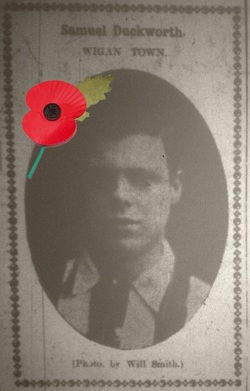
One of the players conspicuous for his consistent displays with Wigan Town is Samuel Duckworth, who can always be relied upon to give a clever
exhibition.
Duckworth is a Bury youth, and his first connection with “soccer” does not date back very many years. The team to first command his services was Seedfield Rovers.
Then he assisted Zion Warth in the Bury Sunday School League, and subsequently he was seen figuring with Bury St. John’s and Springfield
Rovers in the Central Lancashire League.
It was while he was assisting Freetown in the league just mentioned, that Duckworth’s play came under the notice of Heywood United, who induced him to sign a professional form. Duckworth then had one of the best averages in the Manchester League.
Wigan Town secured his transfer from Haslingden, and he is now regarded as one of the most valuable players in the Springfield Park club’s ranks. He has scored in practically every match this season, and on one occasion he performed the “hat trick.”
His present position is inside left, but he can also play centre forward and inside right with equal success. It is probable that Duckworth will be seen with a First Division
Club before long, as his play has been admired by more than one important
organisation.
Duckworth is 22 years of age, and he is 5 feet 8½ inches in height. We wish him every success.
(Wigan Examiner : March 27 1907 : page 2, column 1)
Private 9332 Samuel Duckworth of the 6th Battalion East Lancashire Regiment was killed on August 9 1916 during the first Battle of Kut. He is buried in Basra War Cemetery and was survived by his wife and a daughter, Alice.
exhibition.
Duckworth is a Bury youth, and his first connection with “soccer” does not date back very many years. The team to first command his services was Seedfield Rovers.
Then he assisted Zion Warth in the Bury Sunday School League, and subsequently he was seen figuring with Bury St. John’s and Springfield
Rovers in the Central Lancashire League.
It was while he was assisting Freetown in the league just mentioned, that Duckworth’s play came under the notice of Heywood United, who induced him to sign a professional form. Duckworth then had one of the best averages in the Manchester League.
Wigan Town secured his transfer from Haslingden, and he is now regarded as one of the most valuable players in the Springfield Park club’s ranks. He has scored in practically every match this season, and on one occasion he performed the “hat trick.”
His present position is inside left, but he can also play centre forward and inside right with equal success. It is probable that Duckworth will be seen with a First Division
Club before long, as his play has been admired by more than one important
organisation.
Duckworth is 22 years of age, and he is 5 feet 8½ inches in height. We wish him every success.
(Wigan Examiner : March 27 1907 : page 2, column 1)
Private 9332 Samuel Duckworth of the 6th Battalion East Lancashire Regiment was killed on August 9 1916 during the first Battle of Kut. He is buried in Basra War Cemetery and was survived by his wife and a daughter, Alice.
James Harold
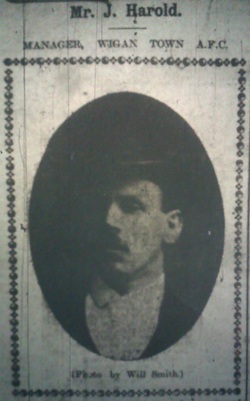
Mr. J. Harold, the secretary and manager of Wigan Town A.F.C., is a Scotchman. He was born in the burgh of Coatbridge, near Glasgow, in 1871.
From his early youth he has always been an enthusiastic follower of the “soccer” game, and he was at one time identified with the Hibernians and Glasgow Celtic. About six years ago he went to Barnsley, and the premier club there carried out
with advantage several of his suggestions.
When he came to Wigan twelve months ago he quickly interested himself in the affairs of Wigan Town. He was deputed to interview Mr. Wall, of
the Football Association, in London, on the question of the Wigan Club’s suspension, and he was no doubt largely responsible for having the suspension
removed. He has also interviewed Mr. Bentley and Mr. Sutcliffe, leading lights in the Football League, with most satisfactory results.
Mr. Harold has certainly effected a vast improvement in the affairs of Wigan Town. He has already brought two First Division clubs to Springfield Park, whilst Blackburn Rovers and Aston Villa are shortly to visit Wigan. The fact that he has many friends occupying prominent positions with first class organisations should prove of some advantage to the Town in times to come.
He entertains great hopes of establishing a first class club in Wigan before very long, and no effort will be spared on his part to gain admission to the Second Division.
(Wigan Examiner : April 10 1907 : page 3, column 1)
From his early youth he has always been an enthusiastic follower of the “soccer” game, and he was at one time identified with the Hibernians and Glasgow Celtic. About six years ago he went to Barnsley, and the premier club there carried out
with advantage several of his suggestions.
When he came to Wigan twelve months ago he quickly interested himself in the affairs of Wigan Town. He was deputed to interview Mr. Wall, of
the Football Association, in London, on the question of the Wigan Club’s suspension, and he was no doubt largely responsible for having the suspension
removed. He has also interviewed Mr. Bentley and Mr. Sutcliffe, leading lights in the Football League, with most satisfactory results.
Mr. Harold has certainly effected a vast improvement in the affairs of Wigan Town. He has already brought two First Division clubs to Springfield Park, whilst Blackburn Rovers and Aston Villa are shortly to visit Wigan. The fact that he has many friends occupying prominent positions with first class organisations should prove of some advantage to the Town in times to come.
He entertains great hopes of establishing a first class club in Wigan before very long, and no effort will be spared on his part to gain admission to the Second Division.
(Wigan Examiner : April 10 1907 : page 3, column 1)
Jack Yarwood
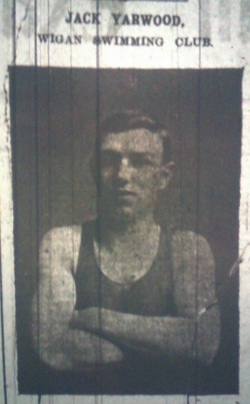
The Wigan Swimming Club are in the happy position of possessing a number of most promising youthful swimmers and water poloists, and amongst the best of these is Jack Yarwood, who has at times figured in the first team. He scored the equalising goal against the Belgians a few weeks
ago.
Yarwood learned to swim in 1902, and he took the second prize in the schoolboys race. He swam with the Wigan Juniors when they won the Squadron
Championship in 1903 and 1904. In 1905 he was given a place in their second team, and he has been one of the most successful players since then.
This year he has been appointed captain of the reserve contingent, and has already placed 22 goals to his credit. He also holds three medals for swimming events.
Yarwood is also a prominent “soccer” exponent, and won several medals while playing for junior clubs. It was while assisting the Tramways eleven last season that he was induced to throw his lot in with Wigan Town, for whom he played in many positions although his correct place is at left half.
Yarwood who is only 18 years of age, has signed for the Town for season 1907-08.
(Wigan Examiner : July 27 1907 : page 3, column 6)
ago.
Yarwood learned to swim in 1902, and he took the second prize in the schoolboys race. He swam with the Wigan Juniors when they won the Squadron
Championship in 1903 and 1904. In 1905 he was given a place in their second team, and he has been one of the most successful players since then.
This year he has been appointed captain of the reserve contingent, and has already placed 22 goals to his credit. He also holds three medals for swimming events.
Yarwood is also a prominent “soccer” exponent, and won several medals while playing for junior clubs. It was while assisting the Tramways eleven last season that he was induced to throw his lot in with Wigan Town, for whom he played in many positions although his correct place is at left half.
Yarwood who is only 18 years of age, has signed for the Town for season 1907-08.
(Wigan Examiner : July 27 1907 : page 3, column 6)
Peter Boyle
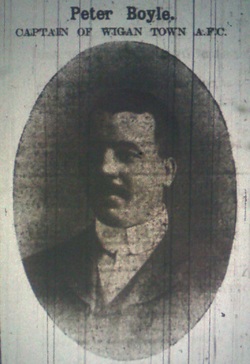
This week we are able to reproduce a portrait of Peter Boyle, the captain of Wigan Town Association team. Boyle has a splendid reputation as a footballer, and it was only the personal influence of Mr. Harold that led him to throw in his lot with the Wiganers. The Springfield Park organisation is
certainly fortunate in having the assistance of such a notable exponent of “soccer,” and we have already tangible proof of the fact that he is destined to play an important part in the history of the dribbling pastime in the old borough.
Boyle was born in Ireland some twenty-nine years ago. He, however, learned his football in Scotland, and represented Coatbridge. His first club of any note was the Albion Rovers, a team which has furnished several distinguished players, among whom may be included Conlin (Manchester City), J.
Scott (Sunderland), A. Scott (Notts Forest), McRoberts (Chelsea), and Cameron
(Blackburn Rovers). On crossing the border Boyle joined the Sunderland ranks, with which he was associated for a couple of years. Then came his transfer to Sheffield United, where he greatly improved his reputation, and at the same time attracted the attention of the Irish selectors. In 1900 he figured against England at Southampton, whilst he captained the Irish team in 1904. It is worthy of note that on the last-mentioned occasion Ireland defeated Scotland for the first time. In all, Boyle obtained six International caps, whilst he also holds three English cup medals.
The Wigan Town organisation displayed sound judgement in appointing Boyle as skipper of the Springfield Park team. As a left-back he is still showing capital form, and with such an experienced man to direct operations the Town should make progress during the present season. They have already created two surprises within seven days, and it looks very probable that they will provide a good many more during the next few months. At any rate, it won’t be Peter Boyle’s fault if they do not.
(Wigan Examiner : September 9 1907 : page2, column 6)
certainly fortunate in having the assistance of such a notable exponent of “soccer,” and we have already tangible proof of the fact that he is destined to play an important part in the history of the dribbling pastime in the old borough.
Boyle was born in Ireland some twenty-nine years ago. He, however, learned his football in Scotland, and represented Coatbridge. His first club of any note was the Albion Rovers, a team which has furnished several distinguished players, among whom may be included Conlin (Manchester City), J.
Scott (Sunderland), A. Scott (Notts Forest), McRoberts (Chelsea), and Cameron
(Blackburn Rovers). On crossing the border Boyle joined the Sunderland ranks, with which he was associated for a couple of years. Then came his transfer to Sheffield United, where he greatly improved his reputation, and at the same time attracted the attention of the Irish selectors. In 1900 he figured against England at Southampton, whilst he captained the Irish team in 1904. It is worthy of note that on the last-mentioned occasion Ireland defeated Scotland for the first time. In all, Boyle obtained six International caps, whilst he also holds three English cup medals.
The Wigan Town organisation displayed sound judgement in appointing Boyle as skipper of the Springfield Park team. As a left-back he is still showing capital form, and with such an experienced man to direct operations the Town should make progress during the present season. They have already created two surprises within seven days, and it looks very probable that they will provide a good many more during the next few months. At any rate, it won’t be Peter Boyle’s fault if they do not.
(Wigan Examiner : September 9 1907 : page2, column 6)
Frank O'Hara
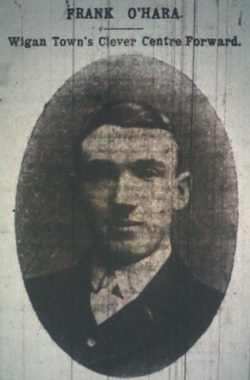
Frank O’Hara, the clever centre forward of the Wigan Town club, who is making himself popular with followers of the “soccer” code in the town,
is a native of Coatbridge, where he was born some 23 years ago. He learned his football at St. Patrick’s School, Coatbridge, and participated in the schools’
competitions of that town, his team winning the championship two seasons in succession.
After leaving school he associated himself with Sarsfield, a junior club in the Coatbridge district. Then he migrated to Glasgow, and joined Strathclyde, with which club he was identified for the short period of four months.
He then had a brief association with Albion Rovers, after which Manager Robertson, of Chelsea, secured his services, and up to the end of season 1906-6 O’Hara figured with the Southern club. In the season named he helped himself to 37 goals.
For family reasons he returned to Scotland, and last season he played with Bathgate, a club which has its home about fifteen miles west of Edinburgh. Wigan were certainly in securing such a redoubtable centre forward, and, as in the case of Peter Boyle, it was owing to the personal influence of Manager Harold that O’Hara threw in his lot with Wigan Town.
O’Hara is a speedy player, passes accurately, and invariably displays sound judgement. A model footballer, he has already demonstrated that Wigan Town made a good “capture” in signing him.
We might add that O’Hara has seen active service with the Highland Light Infantry, with whom he served in the South African campaign.
(Wigan Examiner : September 18: 1907 page 2, column 6)
is a native of Coatbridge, where he was born some 23 years ago. He learned his football at St. Patrick’s School, Coatbridge, and participated in the schools’
competitions of that town, his team winning the championship two seasons in succession.
After leaving school he associated himself with Sarsfield, a junior club in the Coatbridge district. Then he migrated to Glasgow, and joined Strathclyde, with which club he was identified for the short period of four months.
He then had a brief association with Albion Rovers, after which Manager Robertson, of Chelsea, secured his services, and up to the end of season 1906-6 O’Hara figured with the Southern club. In the season named he helped himself to 37 goals.
For family reasons he returned to Scotland, and last season he played with Bathgate, a club which has its home about fifteen miles west of Edinburgh. Wigan were certainly in securing such a redoubtable centre forward, and, as in the case of Peter Boyle, it was owing to the personal influence of Manager Harold that O’Hara threw in his lot with Wigan Town.
O’Hara is a speedy player, passes accurately, and invariably displays sound judgement. A model footballer, he has already demonstrated that Wigan Town made a good “capture” in signing him.
We might add that O’Hara has seen active service with the Highland Light Infantry, with whom he served in the South African campaign.
(Wigan Examiner : September 18: 1907 page 2, column 6)
James Clarke
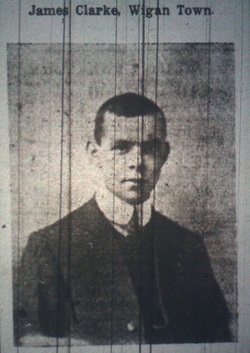
Although the followers of the Wigan Town Club have not yet had the opportunity of judging the capabilities of James Clarke, sufficient is known
of this player to justify the good opinions that have been formed with regard to him.
Clarke was unfortunate enough to be injured in the second trial match at Springfield Park this season, and he has been prevented from making his
appearance in the Town ranks through this accident. It is hoped that he will be fit to turn out in a fortnight.
The first football club to which Clarke became attached was Scot Lane, for whom he played in the Bolton and District League. Afterwards he joined
Adlington, and he gave such an excellent display against the Wiganers in the Lancashire Junior Cup Competition that the management of the Springfield Park Club approached him, and secured his transfer.
He was previously sought after by one or two prominent clubs, and Chorley were anxious to acquire him. He is 22 years of age, and stands 5 feet 11 inches. Clarke’s position is at right half-back.
(Wigan Examiner : October 16 1907 : page 2, column 4)
of this player to justify the good opinions that have been formed with regard to him.
Clarke was unfortunate enough to be injured in the second trial match at Springfield Park this season, and he has been prevented from making his
appearance in the Town ranks through this accident. It is hoped that he will be fit to turn out in a fortnight.
The first football club to which Clarke became attached was Scot Lane, for whom he played in the Bolton and District League. Afterwards he joined
Adlington, and he gave such an excellent display against the Wiganers in the Lancashire Junior Cup Competition that the management of the Springfield Park Club approached him, and secured his transfer.
He was previously sought after by one or two prominent clubs, and Chorley were anxious to acquire him. He is 22 years of age, and stands 5 feet 11 inches. Clarke’s position is at right half-back.
(Wigan Examiner : October 16 1907 : page 2, column 4)
John Halsall
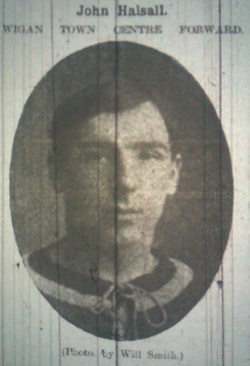
In John Halsall, Wigan Town have an exceptionally clever centre forward, and one who, considering that he is a very young player, should make a name for himself in the Association world.
Halsall showed promising form when he appeared with the schoolboys of St. Andrews many years ago, and he was one of the best players in the smart combination from the Woodhouse lane school.
The first “club” of note to which he became attached was Ince Amateurs, and whilst assisting them he came under the nose of the Bryn Central
officials, with the result that he was induced to turn out with the Bryn eleven.
He gave several splendid displays for them early in the present season but he was evidently not “at home” with the Bryn Club, and was anxious to join Wigan Town, for whom he signed on and has assisted since.
Although one of the smallest exponents in the Combination – and it is averred by many that a small player is of little use in the centre position – Halsall has been a somewhat prolific scorer for the Town. May he “bag” many more goals for them.
(Wigan Examiner : March 3 1908 : page 3, column 6)
Halsall showed promising form when he appeared with the schoolboys of St. Andrews many years ago, and he was one of the best players in the smart combination from the Woodhouse lane school.
The first “club” of note to which he became attached was Ince Amateurs, and whilst assisting them he came under the nose of the Bryn Central
officials, with the result that he was induced to turn out with the Bryn eleven.
He gave several splendid displays for them early in the present season but he was evidently not “at home” with the Bryn Club, and was anxious to join Wigan Town, for whom he signed on and has assisted since.
Although one of the smallest exponents in the Combination – and it is averred by many that a small player is of little use in the centre position – Halsall has been a somewhat prolific scorer for the Town. May he “bag” many more goals for them.
(Wigan Examiner : March 3 1908 : page 3, column 6)
Mann Hilton

It cannot be said of the Wigan Town Management that they do not encourage “soccer” players in this district. In fact innumerable instances can be given of players “picked up” in junior teams in the Borough and the surrounding district, and given a training in a higher class of football.
This has had the effect of producing some very capable local players, and several of them have found their way into First Division teams. The Town Club certainly deserve to be better supported, if only by reason of this fact.
Our celebrity this week is one of a number of players who caught the eye of Wigan Town “scouts,” and he can be marked out as one of the trickiest forwards at the disposal of the Springfield organisation.
Emmanuel Hilton, or “Mann,” as he is more familiarly known, is only at the beginning of his football career. He is only young and it is only a season or two ago that he was operating in junior football. His comrade then, as well as at the present time, was Halsall, another forward of the Town Club.
Hilton first threw in his lot with Wigan St. Andrews, and from that club he transferred his allegiance to Ince Amateurs, who at that time were a very clever team. From here Hilton was “bagged,” and packed off to Springfield Park, where he is a big
favourite.
Our celebrity is a dapper little forward, and one of the cleverest dribblers in the Combination. He is on the light side, but he and his diminutive companion, Halsall,
are a splendid couple of forwards, who have gained for themselves an excellent
reputation.
(Wigan Examiner : April 7 1908 : page 3 , column 5)
This has had the effect of producing some very capable local players, and several of them have found their way into First Division teams. The Town Club certainly deserve to be better supported, if only by reason of this fact.
Our celebrity this week is one of a number of players who caught the eye of Wigan Town “scouts,” and he can be marked out as one of the trickiest forwards at the disposal of the Springfield organisation.
Emmanuel Hilton, or “Mann,” as he is more familiarly known, is only at the beginning of his football career. He is only young and it is only a season or two ago that he was operating in junior football. His comrade then, as well as at the present time, was Halsall, another forward of the Town Club.
Hilton first threw in his lot with Wigan St. Andrews, and from that club he transferred his allegiance to Ince Amateurs, who at that time were a very clever team. From here Hilton was “bagged,” and packed off to Springfield Park, where he is a big
favourite.
Our celebrity is a dapper little forward, and one of the cleverest dribblers in the Combination. He is on the light side, but he and his diminutive companion, Halsall,
are a splendid couple of forwards, who have gained for themselves an excellent
reputation.
(Wigan Examiner : April 7 1908 : page 3 , column 5)
© Janitor Productions 2013
